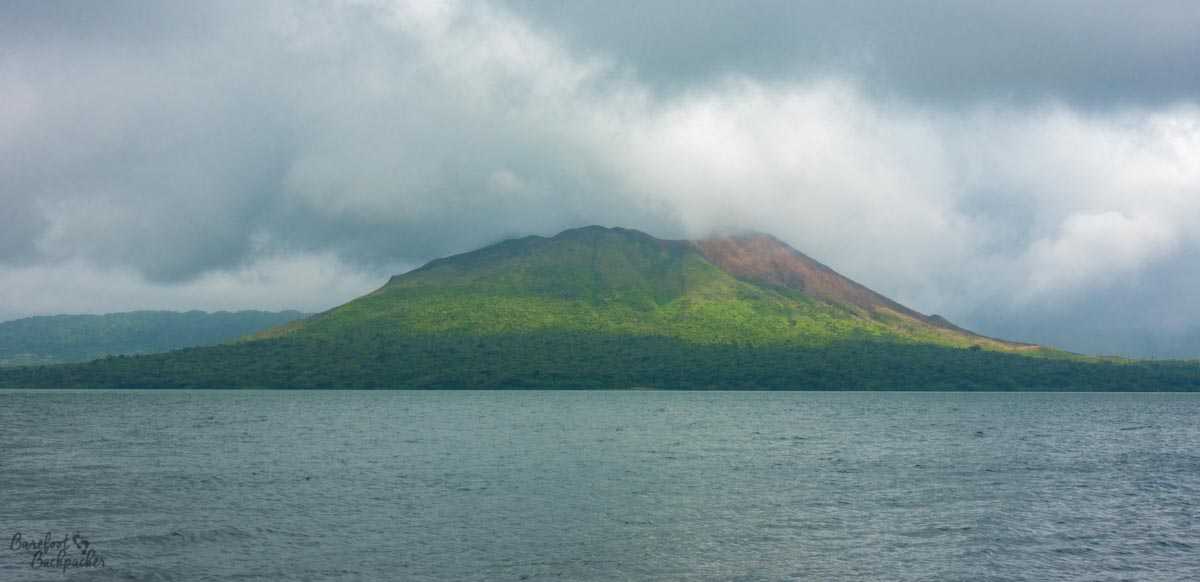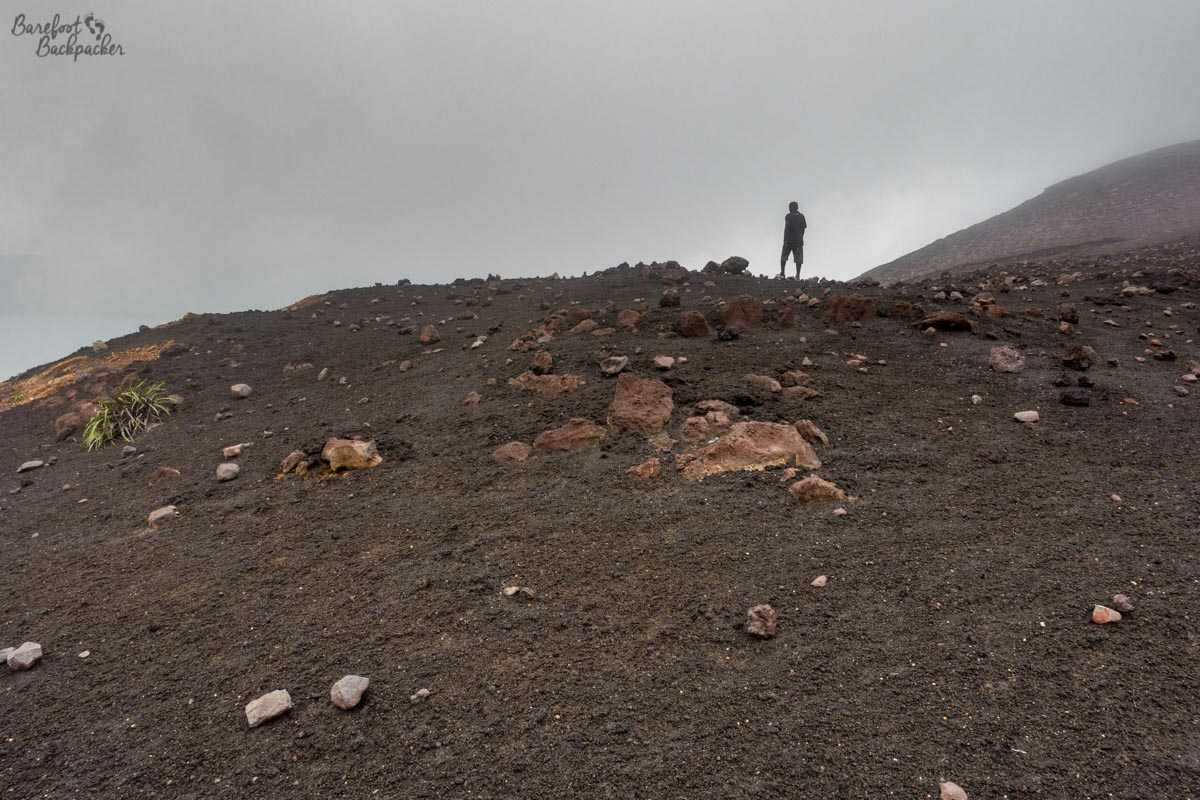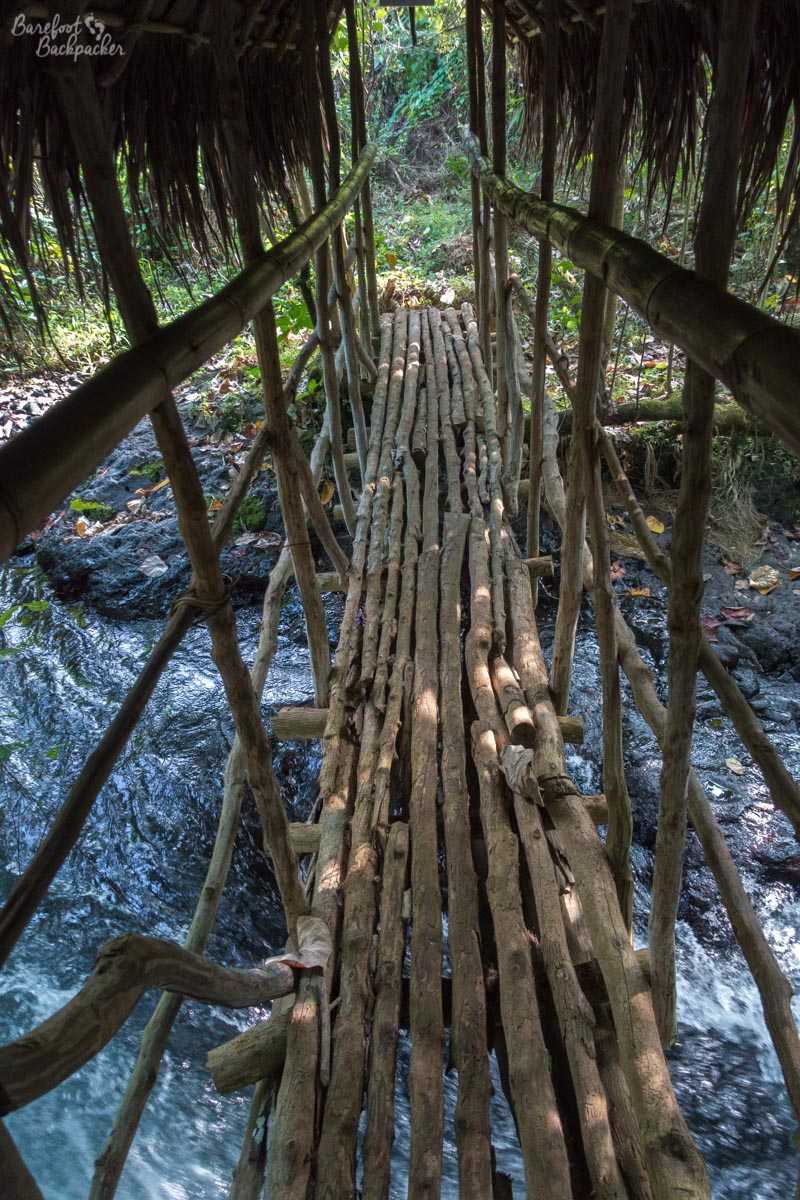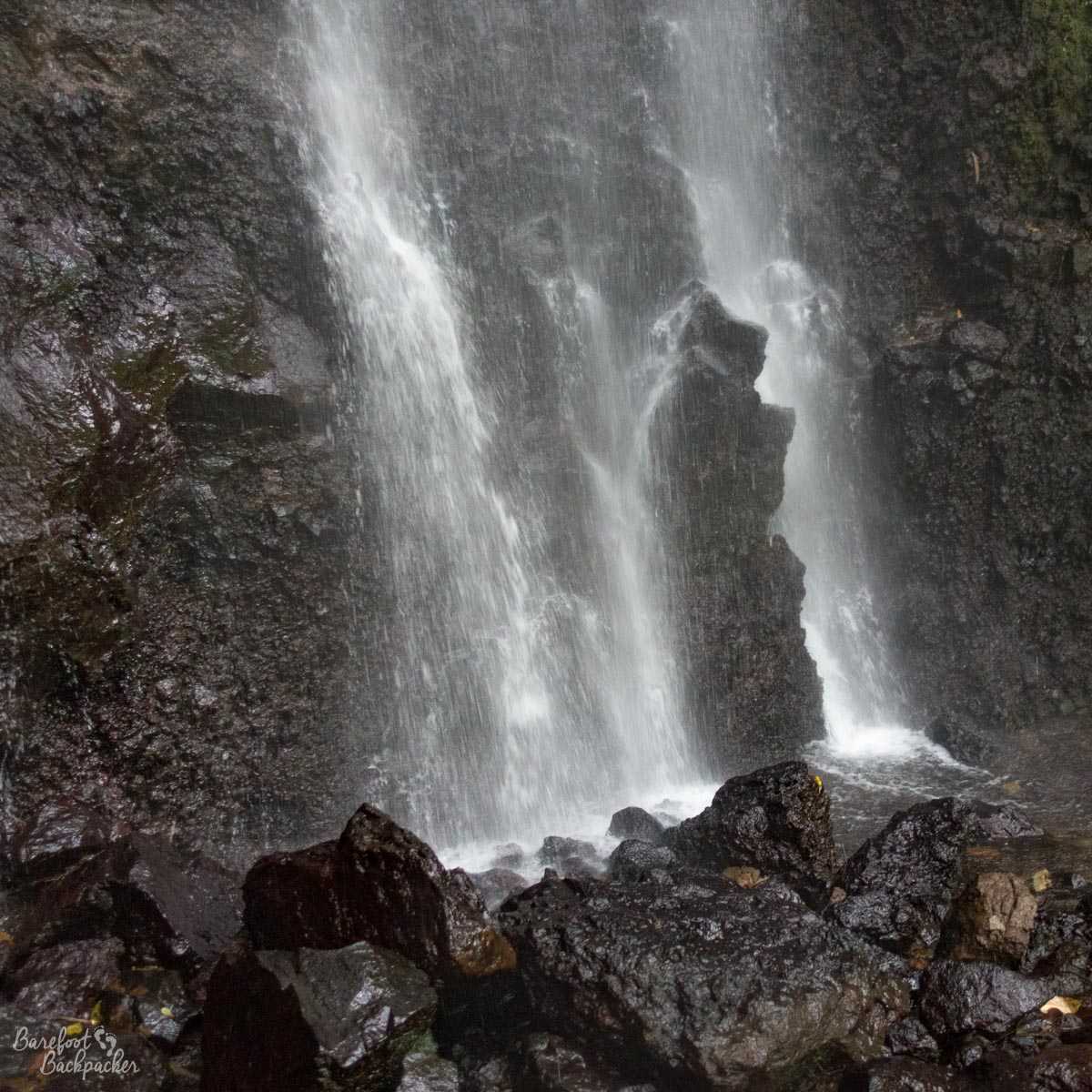Five Days On Gaua
My itinerary had me spending just under 4 weeks in Vanuatu, so obviously this meant I had time to look around at other interesting islands other than Malekula and Ambrym. One that caught my eye was an island in the north, called Gaua. There wasn’t much written about it in the guidebooks, other than it was small and relaxing, but had a waterfall, a volcano, a lake, and some traditional musical culture. It seemed like a good place to walk around for a day or so, then take some time to rest and write. However, my five days on Gaua did not turn out quite how I planned them …

My plane at Gaua Airport, being loaded with luggage. The terminal building is on the mid-left. Heathrow it ain’t!
Gaua is the southernmost of the islands in Torba province, which is made up of the Banks and Torres Islands in the far north of Vanuatu - from the northernmost it’s possible on a clear day to see the Solomon Islands in the distance. It’s a very different sort of island to Efate, Santo, or even Malekula, and that’s clear from the moment you land. On a runway made entirely of grass. When there are no planes due (it gets maybe four a week), it’s basically a park; everyone uses it as a footpath to the beaches and a couple of villages on the far side, and the the local children use it to play football on.

My home on Gaua for five nights. Simple but clean; all you need, really.
I was staying at ‘Tammas Bungalows’, one of several guesthouses on Gaua that provide a traditional hut with a double bed, breakfast, and, if requested, lunch and evening meal. Like everywhere else in the outlying Vanuatan islands, you’re effectively staying in an annex building of the owner’s own house. There was no Internet, limited running water, and an electricity generator that operated 6pm-10pm. The view of the stars at night was awesome, and the bungalow complex was situated right next to the runway (it even advertises itself on the separating wall) which gives you a great view of the planes taking off and landing. Mainly the ‘flying doctor’ in a small cessna-like plane who services the rest of Torba province.

The ‘Flying Doctor’, about to take off from Gaua Airport.
When I wasn’t hiking or attending ceremonies, I spent some of my time just wandering down the roads or over the airfield towards the coast. The beaches in the area are stony rather than sandy, and the locals use them for bonfire/picnic sites.

One of the typical beaches on the island of Gaua. The island is more geared to hiking than beach-bumming.
Anyway.
Day One - Wednesday (Splish Splash)
The plane landed about lunchtime, a little earlier than scheduled (it left Luganville 20 minutes ahead of schedule because everyone was on board and it saved waiting around. This would never happen in Britain). I’d originally planned to see the traditional ‘water music’ on this day, but because ‘island time’, I didn’t end up seeing it until the Monday (day six!) when, because ‘island time’, my departing plane was over three hours late (and yet still arrived in Luganville early! Don’t ask …).
The ‘water music’ is a traditional form of music and dance practised exclusively by women on these northern islands - it’s especially noted on Gaua. Some villagers have taken to performing it for tourists in special shows in Luganville and even Port-Vila, so that people who can’t get out to Gaua can see it. “But of course it’s not the same”, as the women on Gaua told me.

The ladies on Gaua performing one of the Water Music dances.
I found it quite unusual, and probably wasn’t what I would have expected, had I had expectations. By using primarily their hands, they ‘beat’ the water in rhythm, with such force and technique that the water itself doesn’t just make a noise, it makes a particular melodic sound; they perform usually in a line of maybe 6 or 7 so with each of them doing the same, the water really does ‘make music’. From a distance, it looks like the splashing should really hurt, but apparently it doesn’t.
The splashing from the majority of the performers provides the instrumentation for a couple of them to dance. Some of the dances are symbolic of village life - cooking, fishing, etc -, while others represent the animals that provide support to the villagers; one such dance commemorates the dolphin, and has one of the women mimicking it in both movement and call.
It’s a form of dance and music strictly reserved for the women of the villages, and they start practising from a young age - pretty much once they can swim, to be honest - and do so a couple of times a week. It’s not something that exists purely for tourists; they see it more as a sport, and there are even regular competitions between the villages on Gaua to see which has the best water music/dance troupe.
Days Two and Three - Thursday/Friday (Smoke On The Water)
One of the main reasons why I chose to visit Vanuatu was because of volcanoes; I’d never climbed one and indeed had only ever vaguely seen one in the distance (Mt Vesuvius, for the record. It was covered in cloud much of the time). While the one on Gaua was not the one I’d come all this way to see (they were on Ambrym), it seemed silly to visit a small island and not go to its main focus point. Plus, hiking, and by now you can tell I do like my long treks through the forest.

Hiking towards the volcano & lake, guide clearing the path.
The volcano (Mt Garet/Gharat) sits pretty much in the centre of the island, and appears to sit at first viewing on an island in the middle of a lake - this is Lake Letas, which the locals claim is the largest freshwater lake (19 sq km) in the South Pacific. It’s sort-of crescent-shaped and lies to the North and East so while it would be possible to walk to the volcano without crossing the lake, it would be a heck of a detour. Mt Garet is geologically active; indeed it erupted as recently as 2010 causing villages on the West side of the island to be evacuated; the locals returned after about a year.

The view of a cloudy Mt Garet, as seen from the opposite side of Lake Letas.
It stands just over 700m tall; while even the lake is about 420m above sea level, it does mean that it’s a bit of a steep trek to the summit after crossing the lake. It’s possible to do the trek from the villages on the NE coast to the summit and back in a day, but it would make for quite a long trek - it’s about 2-3 hours through reasonably dense foliage to get to even the lake. I overnighted at the lakeside in a small, well they call it a campsite but it’s a series of little huts with a bed inside. Glamping, were it not for the lack of electricity and running water.

Battling across Lake Letas towards Mt Garet in the canoe.
Getting across the lake was done in a canoe with my guide paddling at one end, and the campsite owner, who owns the canoe, paddling the other. Except that just before I got in, the campsite owner uttered the immortal words: “the canoe has a small hole, you’d better take your boots off first.”. The ride over the lake to the island took about 40mins, and every so often the campsite owner would be emptying the canoe of water with a bucket rather than pushing it forward. Yes, we were paddling rather than paddling …

My view inside the canoe. At various points the water was certainly over my toes.
The top of the mountain has several craters - most of them haven’t erupted for a while and are covered in mud, stones, and green moss. But the desolate landscape gives an eeriness to the place that no amount of greenery can challenge. From the crater that is active there is a constant emitting of steam that means even on dry days the mountain is usually seen with cloud around it - indeed my guides told me that quite often they can’t make it to the mountain at all because of the conditions.

One of the craters on Mt Garet; this one hadn’t erupted for a while.
As it was my first volcano, it was always going to feel a bit weird up there. Conditions meant we couldn’t get a good view of the active crater (at one point we could barely see a foot in front of us due to the steam/cloud), which was a little disappointing, but it was certainly good to be up there. It didn’t smell as badly as I’d expected either, just the occasional whiff of sulphur (I’m British and bloodyminded, I don’t care what IUPAC say, I will never spell it with an ‘f’!). A month or so earlier I’d been walking around the sulphur flats near Rotorua in New Zealand and that was more ikky than this.

Near the cloudy, steamy, summit of Mt Garet; nothing much here but rock.
We got back to the campsite almost just in time before a huge rainstorm descended for the next few hours, stopping just in time for the evening meal. This sort of weather change can happen quite often here, so always remember to bring a change of clothing! Fortunately the day after was back to clear skies so it was a dry, if becoming hot, hike back to the village.

So much steam erupting that it’s hard to see much at all.
Day Four - Saturday (Waterfalls)
One of the outflows of Lake Letas is a river that, not far from the lake itself, towards the East, drops down what the locals say is the largest waterfall in the South Pacific (the residents of Gaua are quite proud of their island it seems and ‘big it up’ at every possible opportunity!). The waterfall is called ‘Siri Waterfall’ - as far as I know there are no lawsuits pending - and the biggest drop is around 120m in height.

About 45 mins trekking away from Siri Waterfall, but still quite dominant.
It’s quite common for people to do the lake, the volcano, and the waterfall in one big 3-day looping hike, but I chose to split it up and do the waterfall separately. Pretty much half the trek to the falls from the village is down the road (about 7km) that skirts the Eastern coast of Gaua. While this makes the total trek to/from the falls in one day about 25-30km, it’s much less intense than the trek to the lake & volcano which is jungle path all the way.

The rickety bridge we had to cross on the way to the waterfall.
Two minor points about the trek - not far from the start, you have to cross the river by way of an ornate but very rickety-looking bridge, then a few minutes later by a series of dodgy wooden planks. Then, towards the end near the waterfall itself, there’s a section of path that’s vertical, traversed by very thin ladder-like steps dug into a tree-trunk. It’s not for the faint-hearted, and certainly a few years ago I’d probably have refused.

The tree-trunk made into a ladder. Good thing I’m not scared of heights … oh, wait…
The waterfall itself is pretty powerful. There’s places you can stand, still some distance from the drop, where the amount of cold spray is immense. Bear in mind it was a really hot and sweaty day when I did the trek, after standing by the river for only a few seconds I was cold and drenched, and it was almost impossible to look at the falls, never mind speak, because the water (and noise) was so powerful. It was definitely much-needed.

Though it doesn’t look it, I was still quite a way from the falls at this point. This was as close as I could physically get.
Near the large Siri Waterfall is another, much smaller, waterfall that you can get really up-close and personal with. In addition, this fall is where some of the fresher water goes, so it’s a good place to fill up your water bottles. Between the two is a small picnic site where you can watch the Siri falls from a safe distance.

The smaller waterfalls at the Siri Waterfall site; it was easier to get much closer to these.
Day Five - Sunday (Take Me To Church)
Now, I am not an outwardly or openly religious man. I was baptised as a toddler in a Methodists, but I’m convinced only because it was the closest church to the house I lived in at the time. My uncle, who I ended up growing up with, didn’t go - his beloved football team (Everton) had a home game that day and that was far more important. I don’t blame him tbh (is football a religion? It has a belief structure and a venue for regular services!). I’m not an Atheist though; the definition of what is a ‘god’ is too complex, and while I don’t worship anything, I’ve always felt that nature itself has godlike powers. Although nature being non-sentient, it’s pointless to do anything more than simply respect and try to understand it better.
Anyway. It was about 9.25am, and I’d been scrubbing my clothes over a bucket of cold soapy water for maybe an hour, when the daughter of the bungalow owners came over to me and asked me if I wanted to go to church. Perhaps surprisingly, I said ‘why not’, though advised she’d have to wait for me to finish and hang my clothes up, I guess I was hoping that she’d give up waiting for me, especially as she seemed to indicate that the service had started at 9am, but she didn’t.
I’ve noticed a lot of religion in Vanuatu - Pentecostalists, Seventh-Day-Adventists, several Jehova’s Witness stalls and meeting houses, and a handful of other Christian denominations. While not as evangelical as West Africa, religion certainly has quite a hold on the people - indeed in my hostel in Port-Vila on my arrival, I could hear one preacher (a Seventh-Day-Adventist) from a couple of blocks away for over an hour on his microphone. In Ambrym I would discuss this with another backpacker as we stumbled upon a missionary post, and conclude that while the country was still full of missionaries, their task appeared to not be to convert people *to* Christianity; rather their aim seemed to be to convert people from one Christian denomination to another.

The small church building in the village I was staying in.
We got to the church about 10am. It was a small, simple building a short way down a track just off the main road. Pentecostalist, for the record. Inside were about six or seven small rows of bench, split in the middle by an aisle. At the end of the aisle was a small open space, behind which was a raised area with a rostrum. The walls of the church were postered with English-language hymn scores. I mention the language because although the service itself was in Bislama, the hymns - no church organ, by the way; the music was provided by a guitarist in the congregation - were sung in English. The service was already in full-swing when we arrived, and we had to excuse our way to the only space available - on the very front row. #Awkward.
The preacher was as stereotypical as it gets - fully suited up with smart hair - and in between hymns he led the service with readings and sermonising; animated voice preaching hellfire and damnation. Or it could have been about the state of play in the Water Music competition for all I knew, since it was entirely in Bislama. But then a very odd thing happened. There was an older chap sat sideways to us, on the edge of the room. When the preacher stepped down, he pretty much hi-fived this other man … who then walked up to the rostrum and started preaching himself.

One of the preachers at the church, in full flow.
That this happened twice more may give you some indication as to how long the ceremony was. Interspersed with the preaching were a couple of audience events; at one point two of the younger girls in the audience (I’m guessing they were maybe 9 or 10 years old) gave us a weird dance routine as if they were performing on ‘Vanuatu’s Got Talent’, and then towards the end the preachers invited anyone to come forward into the open space in front of the rostrum if they needed some words of encouragement in life - most of the assembled did and whatever the preachers were whispering into their ears made the people quite emotional and even start crying.
At the very end of the service (the preacher at the time saying words to the effect, as far as I understood them, of ‘well it’s midday now and much as we’d like to carry on, we know you have to get back to make lunch’) we all shook hands with each other and wished each other a happy day and good luck. Everyone. Hands of all sizes were flying everywhere as people headed to the exit. It’s probably designed to promote unity of spirit but all this ‘happy clappy’ stuff makes me ‘ick’, if we’re being honest.
I was in the service for two hours; many of the congregation had presumably been there from the start, so maybe three hours ish? That feels like quite a long time to me - the rare occasions I’ve been found in church services, they’ve lasted an hour and a half tops. Also, an interesting point to note; almost everyone in the church was either female or a child - there were very few adult men present, apart from the two preachers, the guitarist, and myself. I’m not quite sure why.
--
Like this post? Pin it!!

I visited Gaua between 1-5 August 2018.